Revolution #250, November 13, 2011
Occupy Oakland, November 2:
Thousands Turn Out for General Strike—Marches, Protests, Celebration... Port of Oakland Shut Down
On October 25, the City and the Oakland police tried to violently disperse and shut down Occupy Oakland, seriously wounding Iraq war vet and Occupy supporter Scott Olsen during the assault. The attempt was turned back within days, and on November 2, the Occupy Oakland movement took another big leap. At least 15,000 people, perhaps many more according to some estimates, joined the day-long “General Strike & Mass Day of Action—Everyone to the Streets! No Work! No School! Converge on Downtown Oakland to Help Shut Down the City.”
People across the country heard of these actions that night on the news—and this struck a deep chord among many, many people who took heart when they saw thousands take to the streets to repudiate the violence which had been visited upon the protesters—and stand up to carry the whole Occupy struggle forward.
The day was marked by both celebration... and defiant mass struggle. There was a tangible sense of uplift and joy among the thousands who thronged to downtown Oakland to see so many other people turn out and to have turned back the system’s efforts to crush Occupy Oakland. One Revolution Books staffer who talked to people throughout the day said, “People seem like a weight has been taken off their shoulders—they’ve said how glad they are to see something like this, that maybe change is possible. People have told me, ‘Maybe you’re right, maybe things can be changed.’”
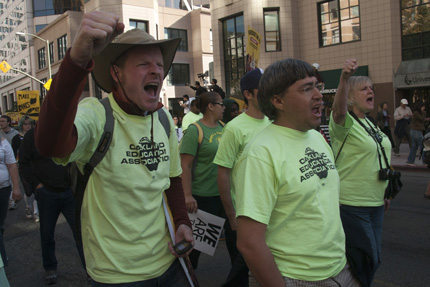 |
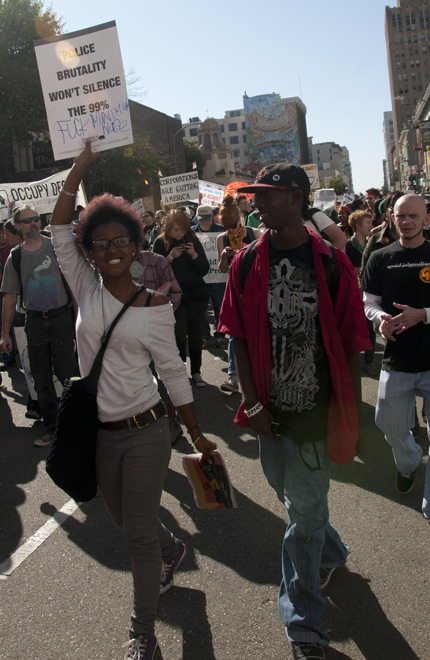 |
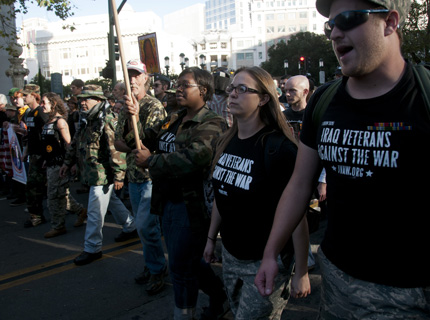 |
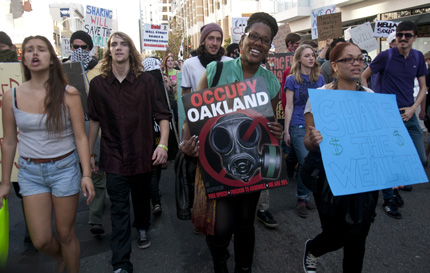 |
| Oakland, November 2 Special to Revolution |
There were also defiant actions. Protesters blocked entrances to some banks and forced them to close temporarily, final notices were placed on the doors of the banks and one woman wrote, “give me back my house.” Students marched to the offices of the University of California Regents. While most of the city remained at work, many businesses did shut down or supported the action in other ways. And the high point of the day was a march of many thousands from downtown to West Oakland that closed down the port of Oakland, the fifth-busiest port in the U.S.
The crowd was very diverse in age, nationality, culture, and politics as many joined the Occupy protests for the first time, and there was a big anti-capitalist thread throughout. There was truth in banner headlines in the Oakland Tribune—“The 99 Percent, United in Anger...Thousands descend on downtown, bringing city to standstill, Protesters mostly peaceful as they decry ‘capitalism run amok.’”
“Today is about saying no to the 1 percent,” one organizer said. Other demands included “end police attacks on our communities” and defending Oakland schools and libraries against budget cuts. There was a kind of ethos that you rarely see in a gathering of that size, of people looking out for each other and getting along across all kinds of social barriers—and in a crowd which was extremely diverse socially. There are, as one aspect of the Occupy movement, ways in which people are fighting for different values. There is a real openness to engaging different ideas and ways of looking at things; there is a sense of a kind of principle of “we SHOULD honestly engage each other’s ideas and dig into them”—which is so contrary to the dominant culture.
The City of Oakland was stung by the outpouring of protest after the vicious police assault against Occupy Oakland on October 25, and for most of the day [Wednesday, November 2] the police maintained a low profile. But late Wednesday night, after most who had joined the general strike had gone home, more than 200 police viciously attacked protesters after some had occupied a vacant downtown building.
According to a Statement on the Occupation of the former Traveler’s Aid Society at 520 16th Street, from “some friends of OO,” (Occupy Oakland) the vacant building, which had housed the Traveler’s Aid Society that served homeless people but had been closed due to budget cuts, had been occupied “to secure the shelter and space from which to continue organizing during the coming winter months.” They had also “hoped to use the national spotlight on Oakland to encourage other occupations in colder, more northern climates to consider claiming spaces and moving indoors in order to resist the repressive force of the weather, after so bravely resisting the police and the political establishment. We want this movement to be here next Spring...”
Five people were injured by the police, including a second Iraq vet. “Kayvan Sabehgi, who served in Iraq and Afghanistan, is in intensive care with a lacerated spleen,” the Guardian (UK) reported. “He says he was beaten by police close to the Occupy Oakland camp, but despite suffering agonising pain, did not reach hospital until 18 hours later.” (“Occupy Oakland: second Iraq war veteran injured after police clashes,” November 4, 2011)
The National Lawyers Guild, which dispatched roughly 50 legal observers to the protest, told Revolution that some 90 people were arrested late Wednesday night for an unlawful assembly (most will be cited and released). According to the NLG, the significant thing was the extreme level of police violence. The NLG has reports that in at least one case, the cops surrounded and trapped people at the plaza and then started shooting at them with tear gas and rubber bullets. They also have reports of two people being hospitalized who were hit by rubber bullets. One man was hit in the face.
While the people have taken a big step forward with the general strike and day of mass action, it is still urgent to take up the battle to defend and strengthen Occupy Oakland and the whole Occupy movement, to prevent the ruling authorities from dividing and/or crushing it, and helping people better distinguish between differences and contradictions between the diverse people united around Occupy and the forces of the system attempting to stomp it out. As we wrote last week, the kind of mix taking place is very exciting, especially for people who see how the society constantly tries to divide different sections of the people. Differences and struggles among the people are different from the “contradictions between the people and the enemy,” between the people on the one hand, and the rulers, their police, and their whole state structure on the other. There is a need to learn to distinguish between the two and to resolve the contradictions among the people in a principled way which serves the interests of the people and enables them to continue to advance the struggle. It is heartening that many thousands were inspired and energized by the general strike, and that hundreds turned out for the first General Assembly (Friday night), following the day of mass action.
General Strike brings many to Occupy Oakland for the first time
The day was supported and joined by many organizations, unions, small businesses, as well as teacher, student, professional and political organizations, and thousands came to downtown Oakland for a day of rallies, marches, and cultural happenings. It began at 7 am Wednesday morning, when people began setting up at Occupy Oakland at 14th and Broadway / Oscar Grant Plaza (officially Frank Ogawa Plaza) in the heart of downtown Oakland. By 9 am, there were probably several thousand downtown, and the general strike gained strength as the day went on. Thousands more—some coming individually, some in groups, some in organized marches—came downtown to join in. And the strike and day of action continued late into the night.
There were three separate marches from UC Berkeley—at 11, 1, and 5—with hundreds of students participating. A teacher in the Peralta Community College system told Revolution that over 1,500 students from the system, which includes Berkeley City College, the College of Alameda, and Laney and Merritt Colleges in Oakland, had marched. Nine students from UC Santa Barbara drove up for the protest. There were students from Holy Names, San Francisco State, and Mills College. Hundreds of high school students came out from Berkeley High, Oakland Tech, Skyline, Mt. Tamalpais, Bishop O’Dowd and no doubt many other schools. One Mills student told Revolution that 100-200 of her classmates had come to the protest; that some teachers had come down with their classes; and that others were using the day to teach about Occupy themes—including decolonization.
There was a convergence in Oakland’s mainly Latino Fruitvale District. There were professional groups—doctors, nurses, architects, and teachers including a contingent of 50-100 from the Oakland Education Association. The Service Workers International and Teamsters unions had a big presence. There were varying reports that five percent of city employees and anywhere from three to 20 percent of Oakland teachers joined the strike.
The San Francisco Chronicle reported, “More than 300 Oakland public school teachers did not show up to work today. City officials allowed public employees to take the day off, but every Oakland police officer was required to show up for work. About 5 percent of city employees called in to say they would be taking either an unpaid furlough or paid vacation day, officials said. Major labor unions in the city expressed support for the movement. Most union workers can not legally strike today, but some said they planned to participate by taking time off or walking off their jobs.”
Oakland School of the Arts closed for the day in solidarity, and at least 20 students came to the protest together. Revolution talked to two sisters, one in the 7th grade, the other in the 8th. The 8th grader said she liked the day—her first protest—because “I can find out what’s going on—I don’t have to just get it from the TV.” One sign said, “We are the 7 billion.”
The Grand Lake Theater’s marquee—visible from the 580 Freeway and normally carrying the names of movies playing—read: “We proudly support the Occupy Wall Street Movement. Closed Wed. to support the strike.”
The crowd of thousands in front of the sound truck at 14th and Broadway would grow in size—sometimes filling the three blocks from 16th to 13th Streets—then ebb as different marches set out in different directions. At 9:55 am there was an “I Will Survive... Capitalism” flashmob, with people dancing in the street to the disco hit “I Will Survive”; at 10 am and again at 12:30 pm “March and Bank Actions/Mobilizations” took place. Later there was a march to the UC Regents building downtown to protest budget cuts, and the Regents’ decision to allow the Oakland Police Department to use their building during the attack on Occupy Oakland. At 2 pm there was an anti-capitalist march. Hundreds, sometimes thousands, joined these actions.
Throughout the day Oscar Grant Plaza was jam packed. Bands and musicians played in the amphitheater right in front of City Hall, where the general assemblies are held, to hundreds of people. Groups had set up literature tables and food dispensaries. There were drum circles. DJ’ed music was pumping out from the Oaklandish store/community space—on Broadway—as people danced on the sidewalk. A festive and celebratory atmosphere prevailed.
Revolution Books had a big table and display area right on Oscar Grant Plaza on 14th Street. It was there to support the Occupy movement—and to let many, many people know about Bob Avakian and the movement for revolution he is leading. To the left of the table—stretching 25 feet, people had stood up five 3x4-foot enlargements of different quotes from BAsics (3:22, 1:3, 2:10, 1:5, and 1:24). Over the day hundreds of people were drawn to the quotes and stopped to study them. (There was also an enlargement of BA’s "Three Strikes" quote and of the July 31 Revolution centerfold—“Who Are the Real Criminals???”) The store had printed up 2,000 copies of the latest Revolution editorial on the Occupy Movement (“Occupy Wall Street, Occupy Everywhere: Police Attacks...Courageous Resistance...Big Stakes for the People,” #249, November 6). The main focus was on getting out Revolution #244, the special issue on BAsics, and on selling the book itself.
The staff of Revolution Books found tremendous openness. By the end of the day some 9,000 copies of #244 had been distributed and nearly 50 copies of BAsics had been sold, as well as other revolutionary literature including the Constitution for the New Socialist Republic in North America (Draft Proposal). One way the store enlisted people in the effort to spread revolution was by printing up 200 of two colorful 11x17-inch two-sided posters—one read “Fight the Power, and Transform the People, for Revolution” on one side, “Get Into Bob Avakian” on the other. The other read “This System has no future for the youth, The Revolution does” on one side, and “Get with the Real Revolution” on the other. Each side included revcom.us at the bottom. People were carrying them, or just taping them to their shirts.
When it got dark, people showed the Revolution talk DVD and deepened the engagement further with some people watching for nearly an hour. “Oh—that’s the guy you’re talking about,” one person said. It was also notable that three former prisoners were drawn to the table because they were thrilled to see the banner supporting the hunger strike. One bought a copy of BAsics for his brother who is in the Pelican Bay SHU.
4 PM—Shutting Down the Port of Oakland
The main event of the day began at 4 pm: a march from downtown to the port of Oakland to shut down the docks (with another march following at 5 pm). Hundreds of Critical Mass bikers had gotten to the port and began shutting it down a little after 4 pm, by preventing trucks from leaving the port facility. By 5 pm the whole operation had been shut down as six busloads of people and thousands of marchers converged on the port. The march topped the bridge leading to the docks and stretched as far as one could see up 7th Street, filling the street. There was amazement that people could bring this all together.
According to a report posted on the Occupy Oakland website (occupyoakland.org):
“The evening march to the Port stretched from downtown to the freeway overcrossing in West Oakland and thousands more protestors kept arriving as the third convergence of the day reached its peak. Over 20,000 people joined the march which made its way to the main entrance of the port and shut it down completely. Port officials confirmed that the workforce was sent home.”
According to one mainstream report, there were 5,000 people at the port, some climbing onto trucks and cargo containers. The authorities planned to keep the port open, but the protesters simply overwhelmed the area. “Nothing is coming in or out of here right now,” a union official stated.
“Whose port? Our port!” many yelled, while dozens climbed on top of the idled trucks and waved signs. “It’s a victory,” exulted one protester, a 21-year-old Oakland art student. “To get all these people together as one unit is amazing.” (San Francisco Chronicle)
“It’s OK,” one trucker whose truck was prevented from leaving told a news camera, “they’re doing it for us, right?”
There was a real current of people trying to picture a different future. One student carried a sign that said, “I want to create more than just wealth.” And Revolution reporters saw a number of people sitting at the gates at the docks reading the Constitution for the New Socialist Republic in North America (Draft Proposal).
What happened in Oakland on November 2 was an important step forward, at a crucial time for the Occupy movement overall. Attacks against the encampments across the country continue. Those in power find the actions of the Occupiers intolerable, precisely because this has been a mass movement that refuses to accept the bounds of what this capitalist system considers “acceptable.” And we have seen that when this movement has deepened and sharpened the focus against the system, and when it has broadened and reached out, when it has responded to police attacks with more determination—it has been able to come out even stronger, carve out more space, and open up new possibilities. This happened in a major way in Oakland, inspiring people all over the U.S. and around the world who yearn for real changes to this world full of injustices and suffering.
Revolution will be carrying further coverage of the general strike and Occupy Oakland.
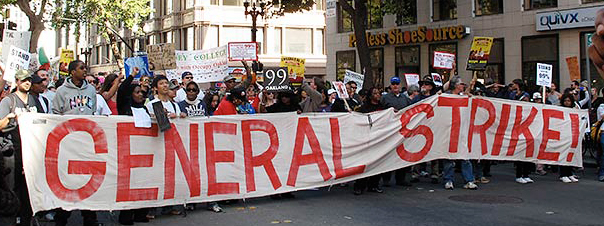 |
| Special to Revolution |
If you like this article, subscribe, donate to and sustain Revolution newspaper.



